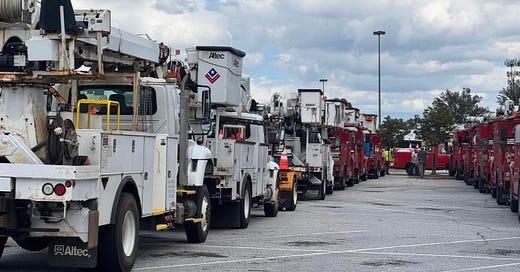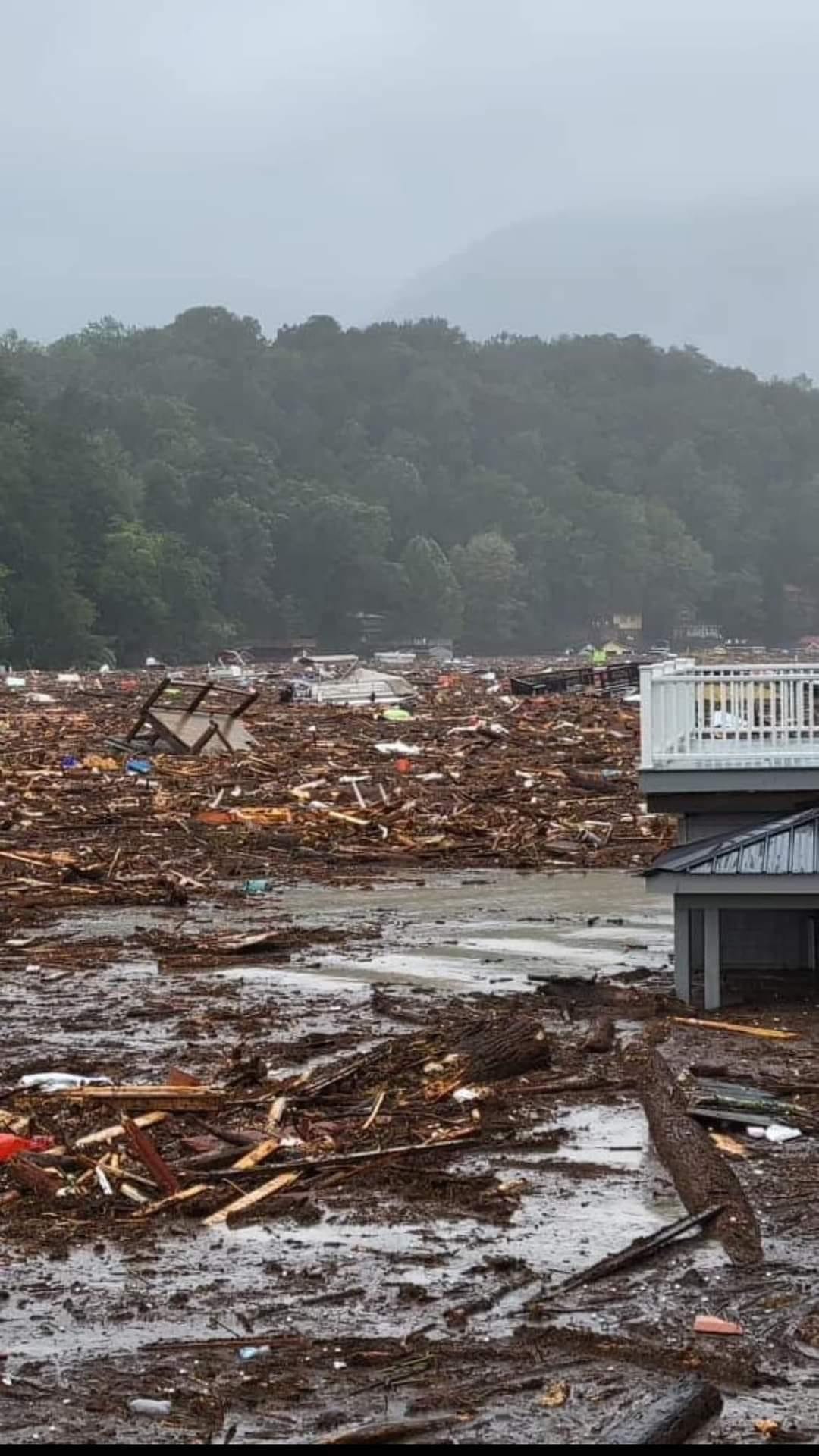Hurricane Helene - Updates and Resources for Greenville County
Councilman Blount’s Newsletter 9-30-24
As we work to recover from Hurricane Helene, I want to provide important updates and share resources to help our community rebuild. Although the storm has passed, the recovery process will take time, and it’s critical that we stay informed and work together to meet the challenges ahead.
Key Recovery Updates
County Council has been receiving updates from the Greenville County Emergency Operations Center (EOC), which has been working tirelessly to coordinate relief efforts. The EOC remains at Operation Condition 1, with multiple agencies engaged in recovery operations.
Key updates include:
• Governor McMaster has requested an expedited Major Disaster Declaration for South Carolina, which would unlock federal disaster relief funds.
• As of Sunday evening, 75% of Greenville County remains without power. Crews from Duke Power and additional teams from nearby counties and Louisiana are working to restore service, but it may take several days to reach everyone.
• Hundreds of roads remain blocked by fallen trees. Multiple teams from both South Carolina and Louisiana are assisting in clearing roads and restoring access.
• Efforts are underway to distribute food and water to those impacted, with updates expected soon.
Power Restoration: Understanding the Process
In the aftermath of Hurricane Helene, many of us are eagerly waiting for power to be restored. Duke Power has brought in trucks and crews from across the country to assist with the recovery efforts. Even though you may not see them working in your area just yet, rest assured that these teams are here and are strategically preparing to take action over the coming days. Below are pictures from the parking lot of Haywood Mall Last night.
It’s important to understand that the process of addressing downed power lines and restoring power is much more complex than it may appear. Crews must follow a step-by-step process to ensure that power is restored safely and efficiently:
1. Damage Assessment: Before repairs can begin, Duke Power teams must first conduct a thorough assessment of the damage across the entire region. This helps prioritize which areas need immediate attention, especially places with critical infrastructure like hospitals and emergency services.
2. Restoring Transmission Lines: Power restoration starts at the source. Major transmission lines must be repaired before crews can address local outages. These high-voltage lines supply electricity to substations that serve entire neighborhoods and communities. If a transmission line is down, repairing smaller, local lines won’t bring power back until the larger system is functional.
3. Clearing Debris: In many cases, downed trees and other debris are tangled with power lines. Crews must work alongside other teams to clear this debris before they can safely restore the lines. This takes time and often requires specialized equipment to avoid further damage or accidents.
4. Prioritization: Duke Power prioritizes critical services, such as hospitals and emergency response centers, followed by areas with the highest concentration of outages. Residential areas and individual homes are addressed after these larger issues are resolved, which can sometimes give the appearance of delays in certain neighborhoods.
While it may feel like nothing is happening, these stages of recovery are necessary to avoid further damage and ensure that power is restored safely. The process is often misunderstood because we tend to only see the local impact, but the larger infrastructure must be stabilized before local repairs can begin.
Why Does This Take Time?
The primary reason for the lengthy process is the interconnected nature of the power grid. Restoring a single line doesn’t always bring power back to individual homes. Additionally, safety remains the top priority. Crews must navigate dangerous conditions—like live wires, flooding, and fallen trees—which slows down the process but ensures no one is put at unnecessary risk.
It’s natural to feel frustrated during these times, but the teams are working around the clock to get things back to normal. In the meantime, please be patient, and remember that safety is always the first priority.
Duke Power is working as quickly as possible to restore power, but it may take time due to the extensive damage. If you come across a downed power line, do not approach or touch it. Immediately report it to Duke Power at 1-800-POWERON (1-800-769-3766).
Shelters and Medical Needs and Services
Two additional shelters are open to assist those displaced by the storm:
Hillcrest High School is providing general shelter services.
The Bon Secours Wellness Arena is serving as a Medical Needs Shelter for individuals who rely on electricity for medical equipment. Caregivers are welcome to accompany them. For more information, call 1-855-472-3432
Reporting Damage and Seeking Assistance
If your property was damaged, it’s essential to report it as soon as possible. You can do so through the SC Emergency Manager App available in the App Store and Google Play. This helps local officials assess the scope of damage and speeds up the process of requesting federal aid.
Additionally, you can already report disaster losses directly to FEMA by clicking here: FEMA Disaster Relief Application
For those with immediate needs such as medical, housing, or food, call 864-467-3428 between 7 AM and 7 PM. As always, please reserve 911 for emergencies!
Cleanup Safety Tips
As cleanup efforts begin, please remember these important safety tips:
• Downed Power Lines: Always assume a downed power line is live and dangerous. Do not attempt to move it—contact authorities immediately.
• Tree Removal: Only remove trees if you have the proper tools and protective gear. If a tree is entangled in power lines, leave it to the professionals.
• Volunteer Safety: If you’re helping with cleanup, wear gloves, protective clothing, and sturdy footwear. Stay hydrated and be mindful of your limits to avoid injury or exhaustion.
Food and Gas Shortages
With many areas still without power, it’s important to be mindful of gas and food shortages:
• Gas: Refuel only if necessary, as lines at stations may be long. Try to conserve fuel by carpooling or limiting unnecessary trips.
• Food: If you’re running low on food, check with local shelters or community organizations. Many are distributing food and water to those in need.
Gratitude for Our Emergency Responders
I want to extend my deepest thanks to the Greenville County Emergency Operations Center and all the agencies involved in managing the response to Hurricane Helene. Much of the information I’ve shared with you has come directly from their team, and I’m incredibly grateful for their tireless, proactive approach in keeping us updated and safe. Their dedication has been a critical part of our community’s recovery efforts.
Prayers for our neighbors in Western NC!
Pictured above is most of Chimney Rock washed into Lake Lure.
While we are recovering ourselves, I think it’s possible to keep others in our thoughts and prayers at the same time. As bad as we have it here in Greenville, our next door neighbor communities in the NC mountains have all but been completely washed away. Many have yet to even establish phone communication and are completely cut off from resources. Some are having to boil water if it’s even available, and the scope is so large that recovery could be months! I am praying for those families as well while we focus on recovery here. I hope you will join me in that effort!
Let’s continue to look out for one another and support our neighbors, especially those most vulnerable. With patience and persistence, we’ll emerge stronger and more united as a community. - BBD19







Thanks again for your comprehensive update! And yes, praying for the folks in North Carolina.
Am I correct in assuming all trash transfer stations are closed?